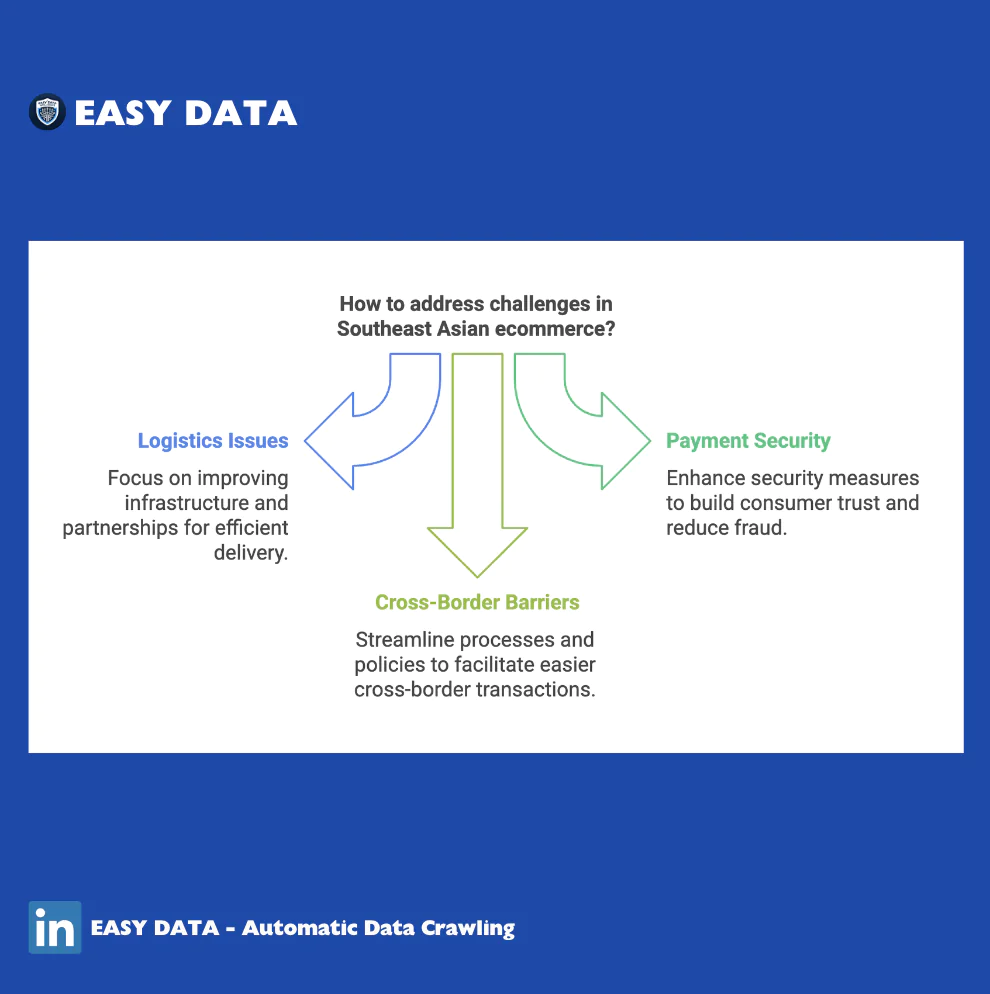Introduction
Ecommerce in Southeast Asia is experiencing unprecedented growth, transforming the region into one of the world’s most dynamic digital markets. With a young, tech-savvy population, increasing smartphone penetration, and government support for digital trade, Southeast Asia’s ecommerce sector is expanding rapidly.
As businesses look to capitalize on this boom, understanding key market trends, opportunities, challenges, and emerging technologies is essential. This article explores the factors shaping ecommerce in Southeast Asia and what businesses need to do to stay competitive.
For real-time ecommerce data and insights, visit Easy Data for expert analytics on Southeast Asian digital markets.

- Introduction
- The Growth of Ecommerce in Southeast Asia
- Key Players Dominating Ecommerce in Southeast Asia
- Driving Factors Behind Ecommerce Growth
- Challenges Facing Ecommerce in Southeast Asia
- Emerging Trends in Southeast Asia’s Ecommerce Landscape
- How Businesses Can Succeed in the Southeast Asian Ecommerce Market
- Conclusion
The Growth of Ecommerce in Southeast Asia
Market Size and Projections
According to Google, Temasek, and Bain & Company, the Southeast Asian ecommerce market is projected to exceed $234 billion by 2025, with major growth seen in countries such as Indonesia, Thailand, Vietnam, the Philippines, Malaysia, and Singapore. This rapid expansion is fueled by:
- Rising internet penetration, with over 440 million internet users across the region.
- Widespread mobile commerce (m-commerce) adoption, with more than 75% of digital transactions occurring on smartphones.
- A growing middle class that is increasingly turning to online shopping.
- Government-backed digital initiatives promoting ecommerce infrastructure.
Leading Ecommerce Markets in Southeast Asia
- Indonesia – The largest market, projected to reach $83 billion by 2025.
- Thailand – A strong player in cross-border ecommerce with $56 billion in projected sales.
- Vietnam – Rapid ecommerce adoption, expected to hit $40 billion.
- Malaysia – High smartphone penetration and a $30 billion digital economy.
- Philippines – Fast-growing ecommerce market with a potential $28 billion valuation.
- Singapore – A regional hub for logistics and fintech, driving digital transactions.
Key Players Dominating Ecommerce in Southeast Asia
Several major platforms have established dominance across the region, including:
- Shopee (SEA Group) – The largest online marketplace in Southeast Asia.
- Lazada (Alibaba Group) – Competing aggressively with Shopee.
- Tokopedia & Bukalapak – Key players in Indonesia.
- Tiki & Sendo – Dominant platforms in Vietnam.
- Zalora & FashionValet – Specializing in online fashion and lifestyle products.
Driving Factors Behind Ecommerce Growth
1. Mobile-First Consumer Behavior
With Southeast Asia having one of the highest mobile penetration rates in the world, mobile commerce (m-commerce) dominates online shopping. Many consumers skip desktops entirely, opting to browse and make purchases exclusively via mobile apps.
2. The Rise of Digital Payments
The shift towards cashless payments is accelerating in Southeast Asia, thanks to the increasing adoption of:
- E-wallets (GrabPay, ShopeePay, GoPay, MoMo, Touch ‘n Go eWallet).
- Buy Now, Pay Later (BNPL) services, allowing consumers to shop with flexible payments.
- Cryptocurrency transactions, gaining traction in select markets.
3. Government Support & Regulations
Governments across Southeast Asia are actively supporting ecommerce growth through policies and incentives, including:
- Digital taxation and consumer protection laws to improve trust.
- Cross-border trade agreements under ASEAN and RCEP.
- Infrastructure investment in logistics and last-mile delivery networks.

Challenges Facing Ecommerce in Southeast Asia
1. Logistics and Last-Mile Delivery Issues
Despite advancements in ecommerce logistics, last-mile delivery remains a major challenge, particularly in rural and remote areas. Businesses must invest in:
- Better supply chain optimization.
- Partnerships with third-party logistics (3PL) providers.
- Micro-fulfillment centers to speed up deliveries.
2. Payment Security & Fraud Risks
While digital payments are growing, cash-on-delivery (COD) still dominates in several markets, increasing fraud risks. Ecommerce businesses must focus on:
- Strengthening payment security measures.
- Educating consumers on digital payment safety.
- Implementing AI-driven fraud detection systems.
3. Cross-Border Ecommerce Barriers
While cross-border ecommerce is a key growth area, import/export regulations, currency exchange fluctuations, and varying tax policies pose challenges. Companies need to:
- Navigate customs laws efficiently.
- Offer localized pricing and payment options.
- Ensure compliance with each country’s ecommerce regulations.

Emerging Trends in Southeast Asia’s Ecommerce Landscape
1. Social Commerce and Live Shopping
Platforms like TikTok Shop, Facebook Live, and Instagram Shopping are reshaping how consumers discover and buy products. Businesses are leveraging:
- Influencer-driven marketing to boost engagement.
- Livestream selling for real-time customer interaction.
- User-generated content (UGC) strategies to enhance authenticity.
2. AI and Personalization
Artificial intelligence (AI) is transforming ecommerce in Southeast Asia through:
- AI-powered chatbots for automated customer support.
- Personalized recommendations based on browsing behavior.
- Predictive analytics for demand forecasting and inventory management.
3. Sustainability and Green Commerce
Consumers in Southeast Asia are becoming increasingly eco-conscious, driving demand for:
- Sustainable packaging and carbon-neutral shipping.
- Ethical sourcing and fair-trade products.
- Brand transparency in environmental impact reporting.
How Businesses Can Succeed in the Southeast Asian Ecommerce Market
1. Localizing Marketing Strategies
Businesses must adapt to local languages, cultures, and preferences by:
- Offering content in multiple languages (Bahasa Indonesia, Thai, Vietnamese, etc.).
- Creating region-specific marketing campaigns.
- Providing customer support tailored to local time zones.
2. Investing in Logistics and Warehousing
Companies should prioritize efficient supply chains by:
- Using AI-driven logistics to optimize deliveries.
- Partnering with local 3PL providers for last-mile success.
- Implementing micro-warehousing for faster fulfillment.
3. Leveraging Data Analytics
Using real-time ecommerce analytics can help businesses:
- Identify market trends and consumer behavior shifts.
- Optimize product pricing and inventory.
- Improve digital marketing effectiveness.
For comprehensive market insights and ecommerce data, visit Easy Data to stay ahead in Southeast Asia’s ecommerce boom.

Conclusion
Ecommerce in Southeast Asia is one of the fastest-growing digital markets in the world, with mobile commerce, digital payments, and government support fueling rapid expansion. However, businesses must navigate logistics hurdles, payment security concerns, and cross-border challenges to succeed.
By leveraging localized strategies, optimizing logistics, and using data-driven decision-making, businesses can capitalize on the booming Southeast Asian ecommerce industry.
For additional insights, check out Statista’s latest ecommerce report and Google’s Southeast Asia Digital Economy report for deeper analysis of regional trends.


Leave a Reply